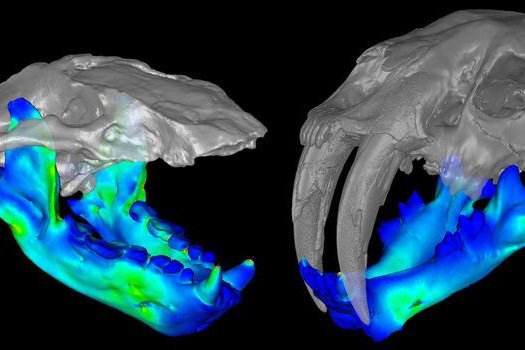1 of 2 | Computer models proved the jaw motions of Kolponomos and Smilodon were remarkably similar. Photo by AMNH
WASHINGTON, March 3 (UPI) -- New ergonomic analysis of the jaw of an extinct "marine bear" species named Kolponomos suggests the otter-like mammal had a bite similar to a saber-toothed cat named Smilodon.
The revelation was detailed this week in the journal Proceedings of the Royal Society B.
Kolponomos lived 20 million years ago: Only a few fossil specimens have been recovered, all from ancient marine deposits of the Pacific Northwest. Scientists believe the marine bear patrolled the coastline, looking for mollusks to eat.
Originally, researchers wanted to examine the fossil evidence to see whether the bear likely cracked and ate clams and mussels like a sea otter -- using a combination of tools and teeth.
"When Kolponomos was first described in the 1960s, it was thought to be a raccoon relative," study co-author Camille Grohe, a paleontologist and research fellow at the American Museum of Natural History, said in a news release. "But later research on the skull base led some to think it might be a seal or a bear relative instead, and studies of its teeth show that they are very similar in both shape and wear to the teeth in sea otters."
But the research took a left turn when Grohe's research partner, Z. Jack Tseng, began to draw connections between his work on the marine bear and a separate project involving Smilodon, the ancient saber-toothed cat.
"I started seeing a great deal of similarity between the jaws of Kolponomos and Smilodon," said Tseng, also a paleontology research fellow at the museum. "Both of them have a distinctive profile with a deep jaw bone that tapers off toward the back, and both have an expansion of the mastoid processes and the skull's back surface."
Their findings suggest both animals could exert tremendous force with their jaws, but with careful control.
The researchers built a model to compare the jaws and jaw motions of Kolponomos and Smilodon to six other carnivores, including grey wolves, sea otters, river otters, brown bears and leopards.
The jaws and biting motions of the marine bear and saber-toothed cat were more similar to each other than to any of the other animals.
Ultimately, the odd research twist offered an answer to their original question -- the marine bear's foraging and consumption methods were quite different than a sea otter's. The bear likely relied exclusively on its jaw to pry mollusks from rocks and crush them with its teeth.
"Our biomechanical data show that the chewing bites of sea otters and Kolponomos are not very similar," Tseng explained. "They probably still have an overlapping diet based on tooth wear, but their evolutionary solutions for getting to those hard-shelled animals are dramatically different."















